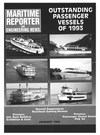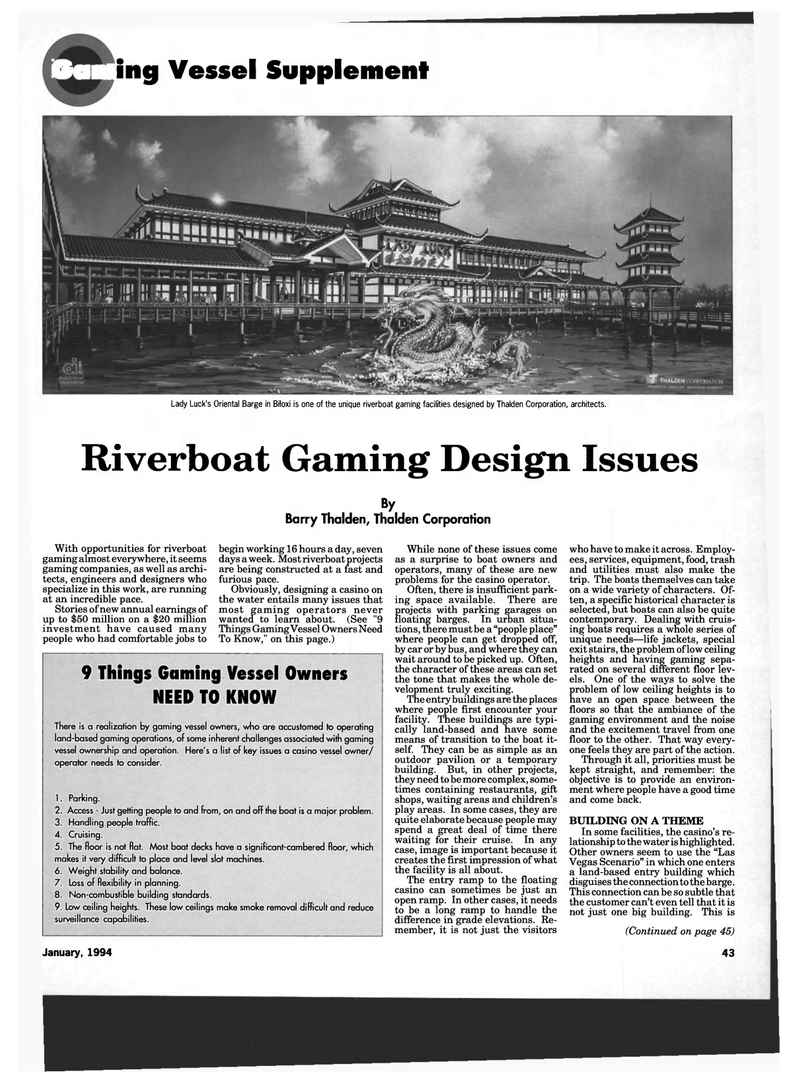
Page 41: of Maritime Reporter Magazine (January 1994)
Read this page in Pdf, Flash or Html5 edition of January 1994 Maritime Reporter Magazine
Gam ing Vessel Supplement
Lady Luck's Oriental Barge in Biloxi is one of the unique riverboat gaming facilities designed by Thalden Corporation, architects.
Riverboat Gaming Design Issues
By
Barry Thalden, Thalden Corporation
With opportunities for riverboat gaming almost everywhere, it seems gaming companies, as well as archi- tects, engineers and designers who specialize in this work, are running at an incredible pace.
Stories of new annual earnings of up to $50 million on a $20 million investment have caused many people who had comfortable jobs to begin working 16 hours a day, seven days a week. Most riverboat projects are being constructed at a fast and furious pace.
Obviously, designing a casino on the water entails many issues that most gaming operators never wanted to learn about. (See "9
Things Gaming Vessel Owners Need
To Know," on this page.) 9 Things Gaming Vessel Owners
NEED TO KNOW
There is a realization by gaming vessel owners, who are accustomed to operating land-based gaming operations, of some inherent challenges associated with gaming vessel ownership and operation. Here's a list of key issues a casino vessel owner/ operator needs to consider. 1. Parking. 2. Access - Just getting people to and from, on and off the boat is a major problem. 3. Handling people traffic. 4. Cruising. 5. The floor is not flat. Most boat decks have a significant-cambered floor, which makes it very difficult to place and level slot machines. 6. Weight stability and balance. 7. Loss of flexibility in planning. 8. Non-combustible building standards. 9. Low ceiling heights. These low ceilings make smoke removal difficult and reduce surveillance capabilities.
While none of these issues come as a surprise to boat owners and operators, many of these are new problems for the casino operator.
Often, there is insufficient park- ing space available. There are projects with parking garages on floating barges. In urban situa- tions, there must be a "people place" where people can get dropped off, by car or by bus, and where they can wait around to be picked up. Often, the character of these areas can set the tone that makes the whole de- velopment truly exciting.
The entry buildings are the places where people first encounter your facility. These buildings are typi- cally land-based and have some means of transition to the boat it- self. They can be as simple as an outdoor pavilion or a temporary building. But, in other projects, they need to be more complex, some- times containing restaurants, gift shops, waiting areas and children's play areas. In some cases, they are quite elaborate because people may spend a great deal of time there waiting for their cruise. In any case, image is important because it creates the first impression of what the facility is all about.
The entry ramp to the floating casino can sometimes be just an open ramp. In other cases, it needs to be a long ramp to handle the difference in grade elevations. Re- member, it is not just the visitors
January, 1994 43 who have to make it across. Employ- ees, services, equipment, food, trash and utilities must also make the trip. The boats themselves can take on a wide variety of characters. Of- ten, a specific historical character is selected, but boats can also be quite contemporary. Dealing with cruis- ing boats requires a whole series of unique needs—life jackets, special exit stairs, the problem of low ceiling heights and having gaming sepa- rated on several different floor lev- els. One of the ways to solve the problem of low ceiling heights is to have an open space between the floors so that the ambiance of the gaming environment and the noise and the excitement travel from one floor to the other. That way every- one feels they are part of the action.
Through it all, priorities must be kept straight, and remember: the objective is to provide an environ- ment where people have a good time and come back.
BUILDING ON A THEME
In some facilities, the casino's re- lationship to the water is highlighted.
Other owners seem to use the "Las
Vegas Scenario" in which one enters a land-based entry building which disguises the connection to the barge.
This connection can be so subtle that the customer can't even tell that it is not just one big building. This is (Continued on page 45) 43

 40
40

 42
42
